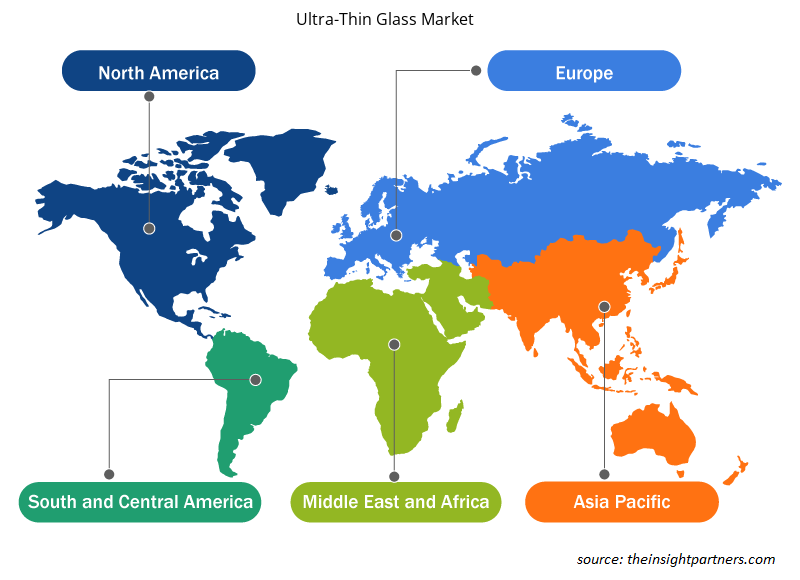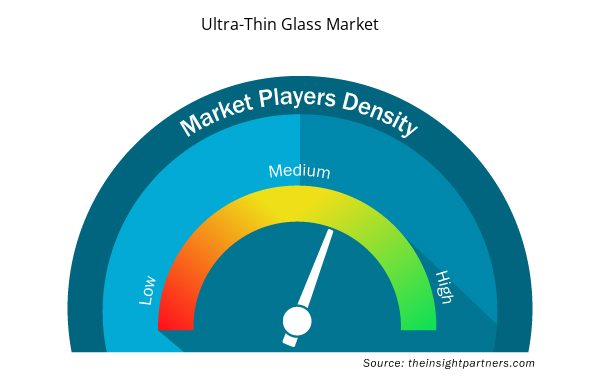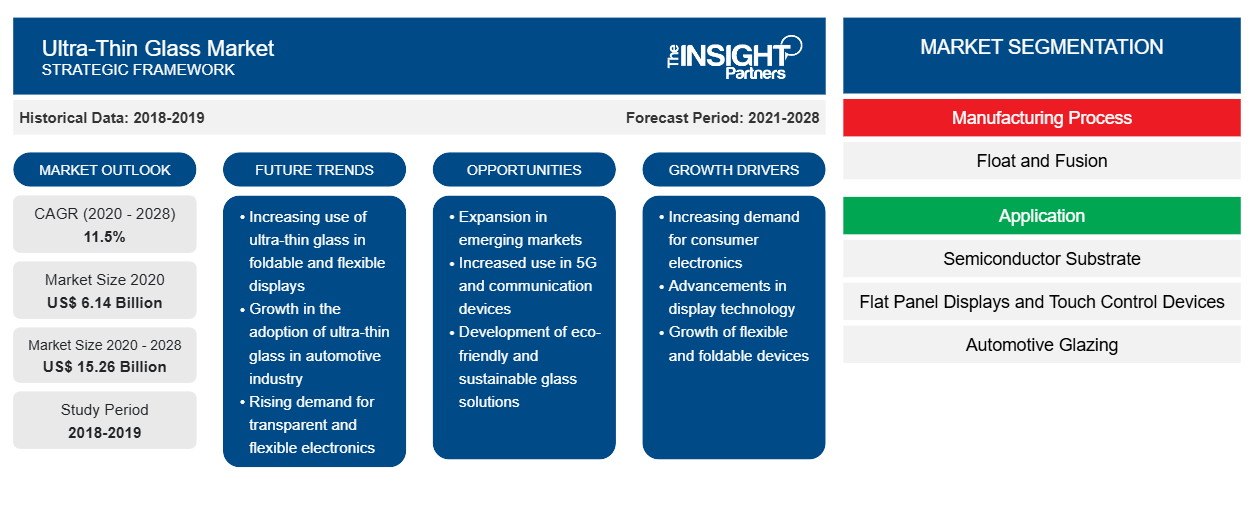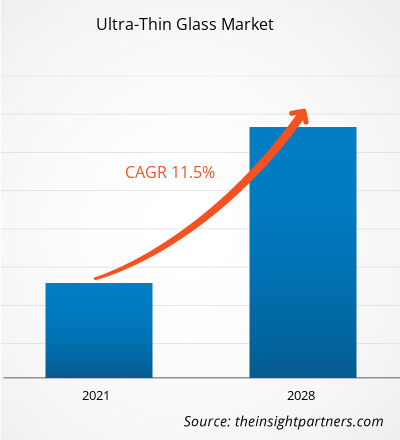[연구보고서] 초박형 유리 시장은 2020년에 6,139.56백만 달러 규모였으며, 2028년까지 15,264.74백만 달러에 도달할 것으로 예상되며, 2021년부터 2028년까지 연평균 성장률 11.5%로 성장할 것으로 예상됩니다.
초박형 유리는 두께가 1~2mm 미만인 유리입니다. 이온 교환을 통한 화학적 강화는 일반적으로 하이테크 응용 분야에 사용되는 초박형 유리를 강화하는 데 사용됩니다. 경화된 초박형 유리는 긁힘에 강하고 반경 몇 밀리미터까지 구부릴 수 있습니다. 내식성, 투명성, 유연성, 뛰어난 가스 및 방수성, 높은 충격 저항성과 같은 초박형 유리의 특성은 평판 디스플레이, 자동차 유리창 등과 같은 다양한 응용 분야에 적합합니다. 2020년에 아시아 태평양 지역은 글로벌 초박형 유리 시장 에서 가장 큰 매출 점유율을 차지했습니다 . 중국은 초박형 유리의 가장 큰 소비자로 아시아 태평양 시장 점유율의 50% 이상을 차지합니다. 이 국가는 스마트폰 및 LCD와 같은 모든 유형의 소비자용 전자 제품의 주요 제조 허브입니다.
진행 중인 COVID-19 팬데믹은 화학 및 재료 부문의 지위를 크게 변화시켰고 초박형 유리 시장의 성장에 부정적인 영향을 미쳤습니다. 신종 코로나바이러스 확산을 막기 위한 조치의 시행은 상황을 악화시켰고 여러 부문의 성장에 부정적인 영향을 미쳤습니다. 자동차 및 가전 제품과 같은 산업은 국가 및 국제 경계의 갑작스러운 폐쇄로 인해 운영 효율성이 갑자기 왜곡되고 가치 사슬이 중단되어 부정적인 영향을 받았습니다. 여러 부문의 성장 감소는 글로벌 시장에서 초박형 유리에 대한 수요에 부정적인 영향을 미쳤습니다. 그러나 경제가 운영을 되살릴 계획이기 때문에 향후 몇 년 동안 전 세계적으로 초박형 유리에 대한 수요가 증가할 것으로 예상됩니다. 팬데믹으로 인해 원격 근무 문화와 온라인 교육이 도입되고 있습니다. 따라서 노트북, 스마트폰 및 기타 통신 장치와 같은 제품에 대한 수요가 증가하고 있습니다. 자동차 및 가전제품과 같은 다양한 산업에서 초박형 유리에 대한 수요가 확대되고, 유명 제조업체에서 상당한 투자를 함에 따라 예측 기간 동안 초박형 유리 시장이 성장할 것으로 예상됩니다.
귀하의 요구 사항에 맞게 이 보고서를 사용자 정의하세요
이 보고서의 일부 또는 국가 수준 분석, Excel 데이터 팩을 포함하여 모든 보고서에 대한 사용자 정의를 무료로 받을 수 있으며 신생 기업 및 대학을 위한 훌륭한 혜택과 할인 혜택을 이용할 수 있습니다.
- 이 보고서의 주요 시장 동향을 알아보세요.이 무료 샘플에는 시장 동향부터 추정 및 예측까지 다양한 데이터 분석이 포함됩니다.
시장 통찰력
성장하는 소비자용 전자 산업
가전제품 산업은 스마트폰, 노트북, 텔레비전 및 기타 전자 제품과 같은 전자 제품의 사용이 증가함에 따라 붐을 이루고 있습니다. 가전제품은 기술 세계에서 필수품이 되었습니다. 모든 세대의 사람들은 어떻게든 스마트폰, 스마트워치 및 노트북에 의존하고 있습니다. 가전제품 산업이 성장함에 따라 제조업체는 지속적으로 고급 고품질 제품을 제공하는 데 주력하고 있습니다. 초박형 유리는 가전제품 산업에서 중요한 역할을 합니다. 터치 및 디스플레이 패널, 센서 및 카메라 시스템에 사용됩니다. 내식성, 투명성, 유연성 및 가스 차단 기능과 같은 초박형 유리의 다양한 특성은 가전제품 산업의 수많은 응용 분야에 적합합니다. 중국은 가전제품 산업에서 우위를 점하고 있습니다. 이 나라는 평판 디스플레이의 저명한 제조업체 중 하나입니다. 중국 스마트폰, 피트니스 트래커, TV 및 기타 전자 제품에 대한 수요가 빠르게 증가하고 있어 초박형 유리 제조업체에게 수익성 있는 기회를 제공합니다. 중국은 새로운 인프라 건설을 강화하고 인공 지능, 산업용 인터넷 및 사물 인터넷의 건설을 촉진했습니다. 5G 상용화 속도를 가속화하여 전자 정보 제조 산업을 새로운 개발 단계로 끌어올리고 관련 산업의 하이엔드 개발을 더욱 촉진합니다. World Population Review에 따르면 중국은 16억 명의 휴대전화 사용자가 있고 인도는 12억 8천만 명의 휴대전화 사용자가 있습니다. 2018년 Apple은 약 2,250만 대의 스마트워치를 출하했습니다. 이 숫자는 2017년보다 증가했으며, 회사는 2017년에 1,770만 대를 판매했습니다. 2018년 Fitbit은 약 550만 대의 스마트워치를 출하했고, Samsung은 약 530만 대를 출하했습니다. 따라서 빠르게 성장하는 소비자 전자 산업은 초박형 안경에 대한 수요를 촉진합니다.
최종 사용 산업 통찰력
소비자용 전자 제품 부문은 2020년에 글로벌 초박형 유리 시장에서 가장 큰 점유율을 차지했습니다.초박형 유리는 LCD, OLED, 스마트폰, 웨어러블 기기와 같은 다양한 기기의 플랫 패널 디스플레이 및 터치 패널 디스플레이와 같은 전자 제품 제조에 널리 사용됩니다. 전 세계적으로 혁신적이고 기술적으로 진보된 전자 제품에 대한 수요가 증가함에 따라 초박형 유리에 대한 수요는 앞으로 몇 년 동안 증가할 것으로 예상됩니다.
제조 공정 통찰력
제조 공정에 따르면, 퓨전 세그먼트는 2020년 수익 면에서 초박형 유리 시장을 지배했습니다. 종종 오버플로우 다운드로우 방법으로 알려진 퓨전 공정은 디스플레이 패널용 평평한 초박형 유리를 제조하는 데 널리 사용됩니다. 코닝은 공중에 떠 있는 특수 유리를 만든 최초의 회사였으며, 이는 퓨전 방법의 핵심 특성입니다. 유리는 용융 금속과 접촉하지 않으며, 이는 플로트 유리 방법에 비해 퓨전 방법의 근본적인 장점입니다.
초박형 유리 시장에서 활동하는 몇몇 주요 시장 참여자는 Corning Incorporated, AGC Inc., Nippon Electric Glass Co., Ltd., SCHOTT AG, Central Glass Co., Ltd., CSG Holding Co., Ltd., Emerge Glass, Nippon Sheet Glass Co., Ltd, Xinyi Glass Holdings Limited, Luoyang Glass Co., Ltd.입니다. 시장의 주요 참여자는 합병 및 인수, 제품 출시와 같은 전략을 채택하여 지리적 입지와 소비자 기반을 확대하고 있습니다.
초박형 유리 시장 지역 통찰력
Insight Partners의 분석가들은 예측 기간 동안 초박형 유리 시장에 영향을 미치는 지역적 추세와 요인을 철저히 설명했습니다. 이 섹션에서는 북미, 유럽, 아시아 태평양, 중동 및 아프리카, 남미 및 중미의 초박형 유리 시장 세그먼트와 지리에 대해서도 설명합니다.

- 초박형 유리 시장에 대한 지역별 데이터 얻기
초박형 유리 시장 보고서 범위
| 보고서 속성 | 세부 |
|---|---|
| 2020년 시장 규모 | 61억 4천만 달러 |
| 2028년까지 시장 규모 | 152억 6천만 달러 |
| 글로벌 CAGR (2020-2028) | 11.5% |
| 역사적 데이터 | 2018-2019 |
| 예측 기간 | 2021-2028 |
| 다루는 세그먼트 | 제조 공정에 따라
|
| 포함된 지역 및 국가 | 북아메리카
|
| 시장 선도 기업 및 주요 회사 프로필 |
|
시장 참여자 밀도: 비즈니스 역학에 미치는 영향 이해
초박형 유리 시장은 소비자 선호도의 변화, 기술 발전, 제품의 이점에 대한 인식 증가와 같은 요인으로 인해 최종 사용자 수요가 증가함에 따라 빠르게 성장하고 있습니다. 수요가 증가함에 따라 기업은 제품을 확장하고, 소비자의 요구를 충족하기 위해 혁신하고, 새로운 트렌드를 활용하여 시장 성장을 더욱 촉진하고 있습니다.
시장 참여자 밀도는 특정 시장이나 산업 내에서 운영되는 회사나 기업의 분포를 말합니다. 주어진 시장 공간에 얼마나 많은 경쟁자(시장 참여자)가 존재하는지 그 규모나 총 시장 가치에 비해 나타냅니다.
초박형 유리 시장에서 활동하는 주요 기업은 다음과 같습니다.
- 코닝 주식회사
- 주식회사 AGC
- 일본 전기 유리 주식회사
- 쇼트 AG
- 센트럴글라스(주)
면책 조항 : 위에 나열된 회사는 어떤 특별한 순서에 따라 순위가 매겨지지 않았습니다.

- 초박형 유리 시장 주요 주요 업체 개요를 알아보세요
스포트라이트 보고서
- 초박형 유리 산업의 진보적 추세는 플레이어가 효과적인 장기 전략을 개발하는 데 도움이 됩니다.
- 선진국과 개발도상국 시장에서 성장을 확보하기 위해 기업이 채택한 사업 성장 전략
- 2019년부터 2028년까지 글로벌 초박형 유리시장의 정량적 분석
- 다양한 산업 분야에서 초박형 유리 수요 추산
- 산업에서 운영되는 구매자와 공급자의 효율성을 보여주기 위한 포터 분석으로 시장 성장을 예측합니다.
- 경쟁 시장 상황과 초박형 유리 수요를 이해하기 위한 최근 개발
- 초박형 유리 시장 성장을 촉진하고 제한하는 요인과 함께 결합된 시장 동향 및 전망
- 글로벌 초박형 유리 시장 성장과 관련된 상업적 관심을 뒷받침하는 전략에 대한 이해, 의사 결정 프로세스 지원
- 시장의 다양한 노드에서의 초박형 유리 시장 규모
- 글로벌 초박형 유리 시장의 자세한 개요 및 세분화와 산업 역학
- 유망한 성장 기회를 가진 다양한 지역의 초박형 유리 시장 규모
제조 공정별 초박형 유리 시장
- 뜨다
- 퓨전
초박형 유리 시장, 응용 분야별
- 반도체 기판
- 플랫 패널 디스플레이 및 터치 컨트롤 장치
- 자동차 유리창
- 기타
최종 사용 산업별 초박형 유리 시장
- 가전제품
- 자동차
- 의료 및 건강 관리
- 기타
회사 프로필
- 코닝 주식회사
- 주식회사 AGC
- 일본 전기 유리 주식회사
- 쇼트 AG
- 센트럴글라스(주)
- CSG 홀딩 주식회사
- 에머지 글래스
- 닛폰시트글라스 주식회사
- 신이유리홀딩스리미티드
- 뤄양 유리 주식회사
- 역사적 분석(2년), 기준 연도, CAGR을 포함한 예측(7년)
- PEST 및 SWOT 분석
- 시장 규모 가치/양 - 글로벌, 지역, 국가
- 산업 및 경쟁 환경
- Excel 데이터 세트



Report Coverage
Revenue forecast, Company Analysis, Industry landscape, Growth factors, and Trends

Segment Covered
This text is related
to segments covered.

Regional Scope
North America, Europe, Asia Pacific, Middle East & Africa, South & Central America

Country Scope
This text is related
to country scope.
자주 묻는 질문
Asia-Pacific is estimated to register the fastest CAGR in the market over the forecast period. The rising demand for LED and OLED televisions is boosting the market growth across the region. Manufacturers of flat panel displays in China, South Korea, and Taiwan are dominating the global marketplace in terms of production and supply of flat panel displays. These displays can be found in cars, industrial equipment, personal computers, smartphones, and a variety of other goods. Liquid crystal displays are used in the majority of TV screens (LCDs). Other display types used in televisions include organic light-emitting diodes (OLEDs) and quantum dots. LCDs and OLEDs are used in smartphone displays. Thus, the high concentration of flat panel display manufacturers in Asia-Pacific, coupled with the high utilization of ultra-thin glass in designing flat panel displays, is the crucial factor anticipated to further drive the market in the coming years. Furthermore, the growing application of ultra-thin glass by automobile manufacturers in China, India, and South Korea is driving the market. China, as one of the significant producers of automobiles, has a high need for ultra-thin glass for use in various automotive interior panels. Furthermore, the existence of significant players such as AGC Inc. and Nippon Electric Glass Co., Ltd is projected to fuel the market expansion.
Based on end use, consumer electronics segment led the global ultra-thin glass market during the forecasted period. Consumer electronics is one of the prominent end-use industries contributing a major share in the growth of the ultra-thin glass market. Ultra-thin glass is widely used to manufacture electronic goods such as flat panel display devices, smartphones, wearable devices, and touch screen devices. It is extremely thin and flexible. Therefore, it is ideal for devices with wider displays and touch screen features. Moreover, it is used in microprocessors of smartphones as a substrate. Using ultra-thin glass in semiconductor substrates ensures the increased performance of microprocessors, which enables high data transfer rates. The growing utilization of ultra-thin glass in consumer electronic devices is expected to boost the market growth. Moreover, the rising demand for electronic gadgets such as smartphones, laptops, tablets, and televisions in emerging economies, owing to rise in disposable income, significant economic development, increase in adoption of emerging technologies, and improved lifestyles of people, is expected to boost the growth of global ultra-thin glass market in the coming years. Manufacturers of ultra-thin glass are focusing on launching innovative products. Recently, foldable ultra-thin glass was developed by Schott AG which is a Germany-based manufacturer of specialty glass products. This foldable glass was used by Samsung in its Z-fold 3 smartphone which is gaining huge popularity among people worldwide. Such innovations by the prominent manufactures of ultra-thin glass are expected to boost the consumer electronics segment’s growth.
On the basis of manufacturing process, fusion segment is leading the ultra-thin glass market during the forecast period. The fusion process, often known as the overflow downdraw method, is widely used to manufacture flat ultra-thin glass for display panels. Corning was the first company to create specialized glass that was suspended in mid-air, which is a key trait of the fusion method. Glass is not contacted by molten metal, which is a fundamental advantage of the fusion method over the float glass method. The raw materials, including pure sand and other inorganic elements, are fed into a massive melting tank that is heated to temperatures beyond 1000â° Celsius. The molten glass is homogenized and conditioned before being discharged into an isopipe, a huge collection trough with a V-shaped bottom. The isopipe is carefully heated to ensure optimum viscosity of the mixture and consistent flow. The molten glass flows uniformly over the isopipe's top edges, generating two thin, sheet-like streams along the outer surfaces. The two sheets meet at the bottom of the isopipe and are fused into a single glass sheet. As the sheet lengthens and cools in mid-air, it feeds into drawing equipment while still linked to the bottom of the isopipe. With precise control of the fusion glass process parameters, thinner glass panels can be produced. Commercial manufacturers such as Corning, Schott, AGC, and Nippon Electric Glass use the drawdown or fusion process for producing ultra-thin glass.
Based on application, flat-panel display segment is expected to grow at the fastest CAGR from 2021 to 2028. Flat panel displays are video devices that replace the conventional cathode ray tube (CRT) with a thin panel design. Ultra-thin glass is widely used to manufacture flat panel displays such as LCD, LED, OLED screens, smartphone displays, and monitor screens. Moreover, ultra-thin glass is used in the touch module of touch screen devices such as smartphones, tablets, and laptops. It provides fundamental functions for flat-panel display and touch screen devices such as high definition (HD) display, touch-control and scratch resistance, and protection to the screens. Consumer electronic goods are being upgraded at a faster rate as the technological landscape is changing rapidly. Panel display components used in flat-panel display and touch-control devices have emerged as the most important downstream application products for ultra-thin glass substrates with the highest market demand. The need for ultra-thin glass substrate is predicted to rise since it is a crucial component and key fundamental material for flat-panel display and touch-control systems. Moreover, ultra-thin glass substrates are non-substitutable and have a promising future as the entire electronic device market develops.
The major players operating in the ultra-thin glass market are Corning Incorporated; AGC Inc.; Nippon Electric Glass Co., Ltd.; SCHOTT AG; Central Glass Co., Ltd.; CSG Holding Co., Ltd.; Emerge Glass; Nippon Sheet Glass Co., Ltd; Xinyi Glass Holdings Limited; and Luoyang Glass Co., Ltd.
In 2020, Asia Pacific held the largest revenue share of the global ultra-thin glass market and is also expected to register the highest CAGR during the forecast period. The ultra-thin glass market across the region is projected to witness remarkable growth, owing to the rapidly expanding consumer electronics industry in countries such as China, Japan, and South Korea. China is one of the largest consumer electronics markets across the world, along with Japan and South Korea. Due to the high concentration of consumer electronics manufacturers in Asia-Pacific, the demand for ultra-thin glass from the manufacturers of electronic goods across the region is expected to grow significantly over the forecast period. Moreover, China and Japan are the leading exporters of semiconductor components used in electronic gadgets. Many leading manufacturers of smartphones and electronic gadgets heavily rely on Asia-Pacific countries for sourcing semiconductor components. For chip packing and interposer applications, the semiconductor industry is progressively designing products using thin glass substrates. When organic substrate materials are employed, the locally generated heat of the small core parts of mobile devices causes deflection and reliability issues. Ultra-thin glass has excellent dimensional stability over a wide range of temperatures while also providing the foundation for an exceedingly flat chip package. Thus, the increasing utilization of ultra-thin glass for designing electronic goods across the region is projected to potentially drive the market over the forecast period.
Trends and growth analysis reports related to Chemicals and Materials : READ MORE..
The List of Companies - Ultra-thin Glass Market
- Corning Incorporated
- AGC Inc.
- Nippon Electric Glass Co., Ltd.
- SCHOTT AG
- Central Glass Co., Ltd.
- CSG Holding Co., Ltd.
- Emerge Glass
- Nippon Sheet Glass Co., Ltd
- Xinyi Glass Holdings Limited
- Luoyang Glass Co., Ltd.
The Insight Partners performs research in 4 major stages: Data Collection & Secondary Research, Primary Research, Data Analysis and Data Triangulation & Final Review.
- Data Collection and Secondary Research:
As a market research and consulting firm operating from a decade, we have published and advised several client across the globe. First step for any study will start with an assessment of currently available data and insights from existing reports. Further, historical and current market information is collected from Investor Presentations, Annual Reports, SEC Filings, etc., and other information related to company’s performance and market positioning are gathered from Paid Databases (Factiva, Hoovers, and Reuters) and various other publications available in public domain.
Several associations trade associates, technical forums, institutes, societies and organization are accessed to gain technical as well as market related insights through their publications such as research papers, blogs and press releases related to the studies are referred to get cues about the market. Further, white papers, journals, magazines, and other news articles published in last 3 years are scrutinized and analyzed to understand the current market trends.
- Primary Research:
The primarily interview analysis comprise of data obtained from industry participants interview and answers to survey questions gathered by in-house primary team.
For primary research, interviews are conducted with industry experts/CEOs/Marketing Managers/VPs/Subject Matter Experts from both demand and supply side to get a 360-degree view of the market. The primary team conducts several interviews based on the complexity of the markets to understand the various market trends and dynamics which makes research more credible and precise.
A typical research interview fulfils the following functions:
- Provides first-hand information on the market size, market trends, growth trends, competitive landscape, and outlook
- Validates and strengthens in-house secondary research findings
- Develops the analysis team’s expertise and market understanding
Primary research involves email interactions and telephone interviews for each market, category, segment, and sub-segment across geographies. The participants who typically take part in such a process include, but are not limited to:
- Industry participants: VPs, business development managers, market intelligence managers and national sales managers
- Outside experts: Valuation experts, research analysts and key opinion leaders specializing in the electronics and semiconductor industry.
Below is the breakup of our primary respondents by company, designation, and region:

Once we receive the confirmation from primary research sources or primary respondents, we finalize the base year market estimation and forecast the data as per the macroeconomic and microeconomic factors assessed during data collection.
- Data Analysis:
Once data is validated through both secondary as well as primary respondents, we finalize the market estimations by hypothesis formulation and factor analysis at regional and country level.
- Macro-Economic Factor Analysis:
We analyse macroeconomic indicators such the gross domestic product (GDP), increase in the demand for goods and services across industries, technological advancement, regional economic growth, governmental policies, the influence of COVID-19, PEST analysis, and other aspects. This analysis aids in setting benchmarks for various nations/regions and approximating market splits. Additionally, the general trend of the aforementioned components aid in determining the market's development possibilities.
- Country Level Data:
Various factors that are especially aligned to the country are taken into account to determine the market size for a certain area and country, including the presence of vendors, such as headquarters and offices, the country's GDP, demand patterns, and industry growth. To comprehend the market dynamics for the nation, a number of growth variables, inhibitors, application areas, and current market trends are researched. The aforementioned elements aid in determining the country's overall market's growth potential.
- Company Profile:
The “Table of Contents” is formulated by listing and analyzing more than 25 - 30 companies operating in the market ecosystem across geographies. However, we profile only 10 companies as a standard practice in our syndicate reports. These 10 companies comprise leading, emerging, and regional players. Nonetheless, our analysis is not restricted to the 10 listed companies, we also analyze other companies present in the market to develop a holistic view and understand the prevailing trends. The “Company Profiles” section in the report covers key facts, business description, products & services, financial information, SWOT analysis, and key developments. The financial information presented is extracted from the annual reports and official documents of the publicly listed companies. Upon collecting the information for the sections of respective companies, we verify them via various primary sources and then compile the data in respective company profiles. The company level information helps us in deriving the base number as well as in forecasting the market size.
- Developing Base Number:
Aggregation of sales statistics (2020-2022) and macro-economic factor, and other secondary and primary research insights are utilized to arrive at base number and related market shares for 2022. The data gaps are identified in this step and relevant market data is analyzed, collected from paid primary interviews or databases. On finalizing the base year market size, forecasts are developed on the basis of macro-economic, industry and market growth factors and company level analysis.
- Data Triangulation and Final Review:
The market findings and base year market size calculations are validated from supply as well as demand side. Demand side validations are based on macro-economic factor analysis and benchmarks for respective regions and countries. In case of supply side validations, revenues of major companies are estimated (in case not available) based on industry benchmark, approximate number of employees, product portfolio, and primary interviews revenues are gathered. Further revenue from target product/service segment is assessed to avoid overshooting of market statistics. In case of heavy deviations between supply and demand side values, all thes steps are repeated to achieve synchronization.
We follow an iterative model, wherein we share our research findings with Subject Matter Experts (SME’s) and Key Opinion Leaders (KOLs) until consensus view of the market is not formulated – this model negates any drastic deviation in the opinions of experts. Only validated and universally acceptable research findings are quoted in our reports.
We have important check points that we use to validate our research findings – which we call – data triangulation, where we validate the information, we generate from secondary sources with primary interviews and then we re-validate with our internal data bases and Subject matter experts. This comprehensive model enables us to deliver high quality, reliable data in shortest possible time.


 이 보고서에 대한 무료 샘플을 받으세요
이 보고서에 대한 무료 샘플을 받으세요